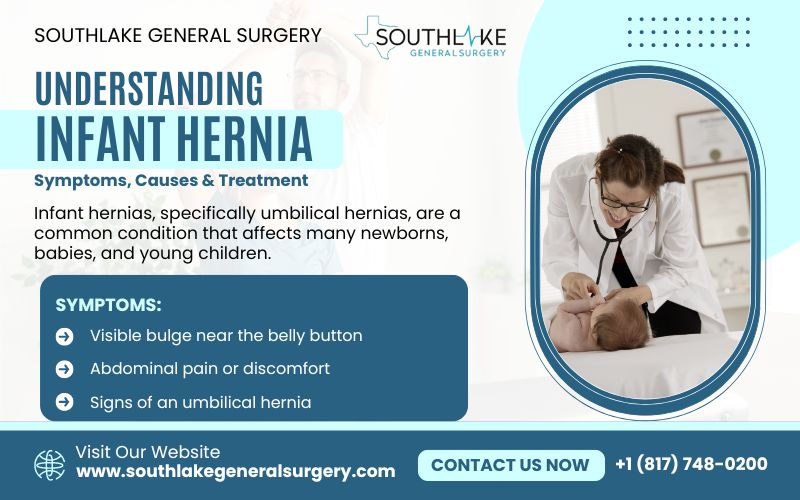Infant hernia, specifically umbilical hernias, are a common condition that affects many newborns, babies, and young children. It occurs when part of the intestine protrudes through the opening in the abdominal muscles near the belly button (umbilicus).
While umbilical hernias are usually harmless and tend to resolve on their own, it is important to understand the symptoms, causes, and treatment options available.
Understanding the types and characteristics of infant hernias is crucial for early diagnosis and appropriate management. Identifying the symptoms of infant hernias can help parents determine when to seek medical attention. Additionally, knowing the causes behind hernias in infants can assist in preventing their occurrence.
This blog explains infant hernia, including what they are, their symptoms, causes, and treatment. It talks about early diagnosis, signs to watch for, and when to see a doctor. It also mentions prevention and care after surgery for babies with hernias. Lastly, it covers what to expect and how to book an appointment with Dr. Valeria Simone at Southlake General Surgery in Texas, USA.
Key Highlights
- An umbilical hernia is a common condition in infants and occurs when part of the intestine protrudes through the opening in the abdominal muscles near the belly button.
- Most umbilical hernias in children heal on their own by the age of 4 or 5.
- In adults, untreated umbilical hernias can lead to complications and may require surgery to put the tissue back into place.
- The common symptoms of an umbilical hernia include a visible bulge near the belly button, soft to the touch, which may be more prominent during crying or straining.
- Early diagnosis of infant hernias is important, as it helps prevent complications and allows for timely treatment.
- Common signs that your baby may have a hernia include a visible bulge, abdominal pain, and signs of an umbilical hernia.
Understanding Infant Hernia
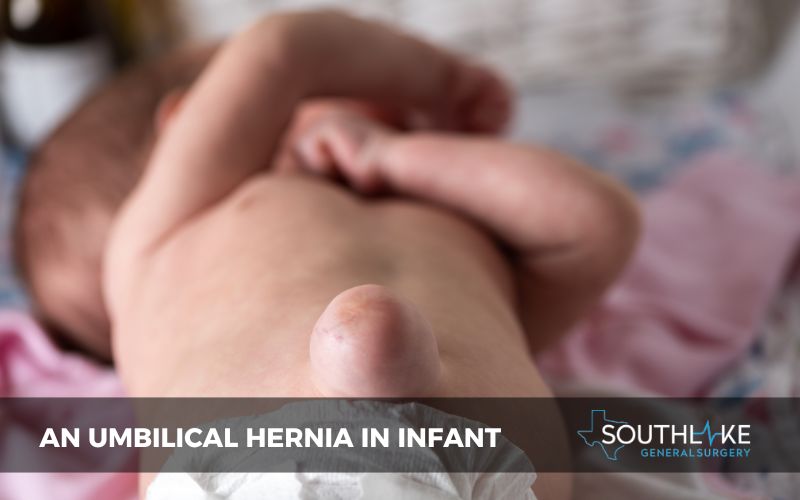
Infant hernias, like umbilical hernias, happen when the intestines or organs push through the abdominal muscles near the belly button. This opening forms when the umbilical cord passes through during fetal development.
Most umbilical hernias are harmless and go away as muscles get stronger. Knowing about infant hernias helps with early detection and proper care.
Defining Infant Hernia: Types and Characteristics
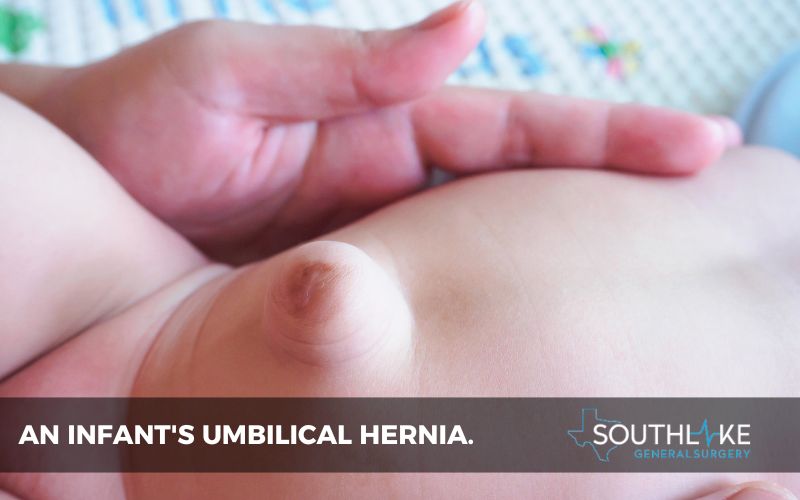
Infant hernias can be categorized into different types based on their characteristics. The most common type is the umbilical hernia, which occurs near the belly button. Umbilical hernias are usually small and present as a soft bulge that can be felt or seen when the baby cries or strains.
Another type of infant hernia is an inguinal hernia, which occurs in the groin area. Inguinal hernias are more common in boys and may appear as a bulge or swelling in the groin or scrotum. It is important to differentiate between these types of hernias to ensure proper diagnosis and treatment.
The Importance of Early Diagnosis in Infants

Early diagnosis of infant hernias is crucial for several reasons:
- Timely intervention and treatment can prevent complications and minimize the risk of long-term health issues.
- Ensures that the baby’s blood supply to the herniated organ is not compromised, reducing the risk of a strangulated hernia.
- Provides parents with peace of mind and allows them to take necessary steps to address the hernia and its associated symptoms.
Consulting a healthcare professional at the earliest signs of a hernia is essential for accurate diagnosis and appropriate management.
Identifying Symptoms of Infant Hernia
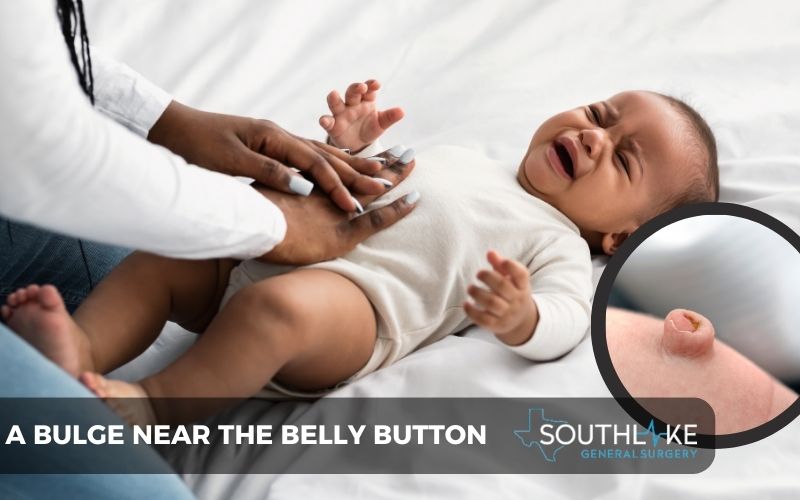
Identifying the symptoms of infant hernia is crucial for early diagnosis and timely intervention. Umbilical hernias are often painless, but parents should watch for specific signs.
One key symptom is a soft bulge near the belly button that may show more when the baby cries or strains. Sometimes, the bulge only appears during crying. Keep an eye on any changes in the bulge’s size or look and consult a doctor if needed.
Common Signs Your Baby May Have a Hernia
- Visible bulge near the belly button, especially during crying or straining
- Abdominal pain or discomfort, which may cause the baby to cry or be irritable
- Signs of an umbilical hernia, such as a soft bulge that protrudes through the belly button and becomes more noticeable during crying or straining
- Swelling or tenderness around the belly button area
It is important to note that, while these signs may indicate a hernia, only a healthcare professional can provide an accurate diagnosis. If you notice any of these signs in your baby, it is recommended to consult a pediatrician or a hernia specialist for further evaluation and appropriate treatment.
When to Consult Dr. Valeria Simone for a Hernia Evaluation
If you suspect that your baby has a hernia or if your baby is experiencing any symptoms that may be indicative of a hernia, it is important to consult a healthcare professional for an evaluation.
Dr. Valeria Simone, a renowned hernia specialist at Southlake General Surgery in Texas, USA, is highly experienced in diagnosing and treating hernias in infants. She can provide an accurate diagnosis and recommend the most appropriate course of treatment based on the individual needs of your baby.
Early intervention and timely treatment can help prevent complications and ensure the best possible outcome for your baby.
Causes Behind Hernia in Newborn
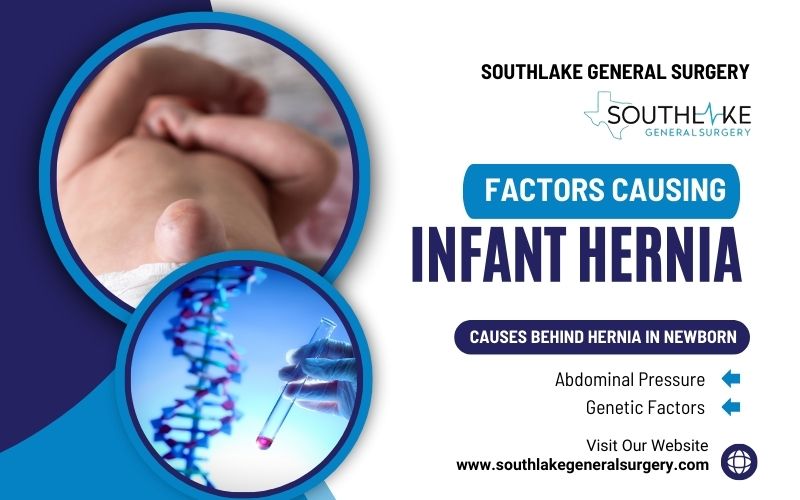
Understanding why babies get hernias can help parents prevent them. The cause of infant hernias isn’t always clear. Genetics and abdominal pressure play a role. Babies might inherit weak muscles or strain their abdomen, leading to hernias. Parents can lower hernia risk by knowing these causes.
Genetic Factors and Hernia Development
Genetic factors can play a role in the development of hernias in infants. Some infants may inherit a predisposition to weak abdominal muscles, making them more susceptible to hernias.
This genetic predisposition can be passed down from parents or other family members who have a history of hernias. While genetic factors may increase the risk of hernia development, they do not guarantee that an infant will develop a hernia.
Other factors, such as abdominal pressure and lifestyle choices, can also contribute to the development of hernias. Parents need to be aware of their family history and take preventive measures to reduce the risk of hernias in their infants.
Lifestyle and Environmental Triggers
In addition to genetic factors, certain lifestyle and environmental triggers can contribute to the development of hernias in infants. Obesity is one such trigger, as excessive weight puts increased pressure on the abdominal muscles, making them more susceptible to weakness.
Medical conditions that cause increased abdominal pressure, such as chronic coughing or constipation, can also contribute to the development of hernias.
Additionally, activities that involve heavy lifting or straining can put a strain on the abdominal muscles and increase the risk of hernia development. By being mindful of these triggers and making conscious choices to reduce their impact, parents can help decrease the risk of hernias in their infants.
Comprehensive Diagnosis Techniques
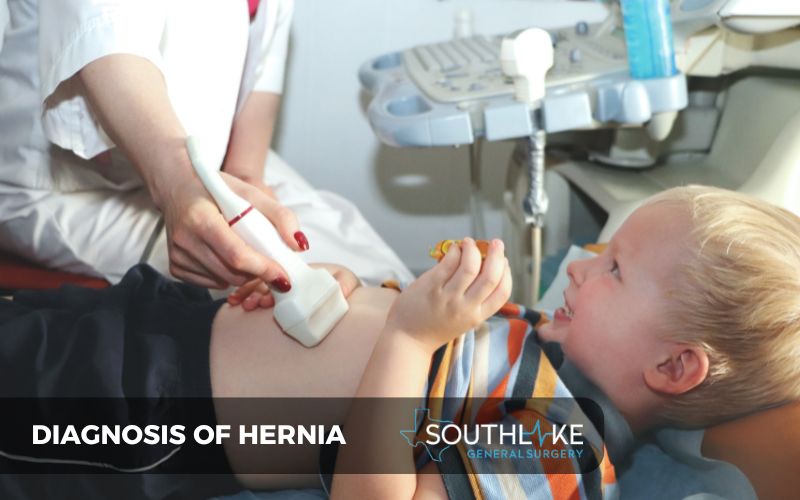
Accurate detection of baby hernias is crucial for proper care and treatment. Diagnosis usually includes physical checks and imaging tests. These methods help doctors understand the hernia’s seriousness and decide on the best treatment plan.
Physical checks may include feeling the belly area and examining the hernia’s size and features. Tests like ultrasound or CT scans offer detailed belly images, aiding in a comprehensive assessment of the hernia and its related parts.
Physical Examinations and Imaging Tests
Physical exams are important to find infant hernia. A doctor looks for bulges near the belly button. They touch the area to check the hernia’s size and features. Sometimes, more tests like ultrasound or CT scans are needed for a better evaluation.
Ultrasound shows the hernia’s size and place. CT scans give a detailed view of the hernia and nearby structures. These tests help doctors diagnose patients correctly and plan treatment effectively.
Preparing Your Infant for a Hernia Diagnosis
Preparing your infant for a hernia diagnosis involves a few important steps. Firstly, it is important to schedule an appointment with a healthcare professional who specializes in hernia diagnosis and treatment, such as Dr. Valeria Simone at Southlake General Surgery in Texas, USA.
Before the appointment, gather any relevant medical records or information about your infant’s symptoms and medical history. During the appointment, be prepared to answer questions about your infant’s symptoms, as well as any family history of hernias.
The healthcare professional will perform a physical examination and may recommend additional tests, such as ultrasound or CT scans, to confirm the diagnosis. It is important to stay calm and provide comfort to your infant during the examination to ensure a smooth and accurate diagnosis process.
Modern Treatment Options at Southlake General Surgery
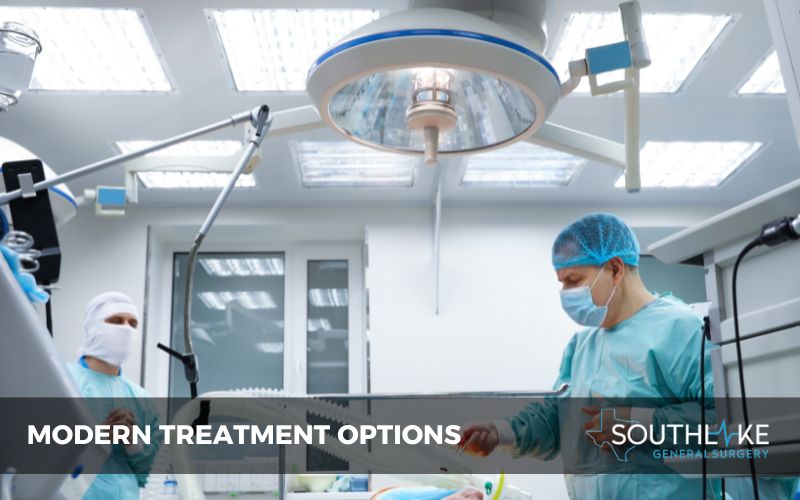
At Southlake General Surgery, we offer modern treatment options for infant hernias. Depending on the severity and type of hernia, non-surgical approaches or surgical repair may be recommended. Our experienced surgeons specialize in hernia repair surgery, using advanced techniques to ensure the best possible outcomes for our patients.
We understand that each case is unique, and we work closely with our patients and their families to develop personalized treatment plans. Whether it’s a small umbilical hernia or a more complex case, you can trust our team to provide the highest standard of care.
Non-Surgical Approaches and Their Effectiveness
Non-surgical approaches are often considered for the treatment of umbilical hernias in infants. These approaches aim to allow the hernia to close naturally over time. In some cases, a small hole or opening in the abdominal muscles can gradually close on its own, especially in infants.
The success of non-surgery methods differs based on hernia size and seriousness. Small hernias may close without surgery, but big ones might need surgery. Talk to your child’s doctor to decide the best treatment for the hernia. It is advisable to have regular check-ups to ensure proper healing.
Hernia Repair Surgery: What to Expect
For umbilical hernias that require surgical intervention, hernia repair surgery is a common treatment option. During the procedure, a small incision is made near the hernia site. This allows the surgeon to access the hernia and repair the abdominal wall.
The surgery is typically performed under general anesthesia to ensure the comfort of the infant. The surgeon will carefully push the protruding tissue back into place and strengthen the abdominal wall to prevent future hernias. In some cases, surgical mesh may be used to provide additional support.
Recovery from umbilical hernia repair surgery is typically quick, with most infants able to resume normal activities within a few days. However, it’s important to follow the surgeon’s post-surgery care instructions and attend follow-up appointments for monitoring and assessment of the healing process.
Post-Surgery Care and Monitoring

After hernia repair surgery, proper post-surgery care and monitoring are essential for a smooth recovery. The recovery process varies depending on the individual and the specific surgical approach used.
Your child’s surgeon will provide detailed instructions on how to care for the surgical site, manage any discomfort, and prevent complications.
It’s important to keep the surgical site clean and dry, follow any restrictions on physical activity, and administer any prescribed medications as directed. Regular monitoring appointments will be scheduled to ensure proper healing and to address any concerns or questions you may have.
Recovery Process and Timeline for Infants
The recovery process for infants after hernia repair surgery is typically quick and straightforward. Most infants tolerate the surgery well and experience minimal discomfort. Stitches or sutures used to close the incision will dissolve on their own over time, eliminating the need for their removal.
The timeline for recovery can vary depending on the individual, but most infants can resume normal activities within a few days.
It’s important to closely follow the surgeon’s post-surgery care instructions to ensure optimal healing. If you have any concerns or notice any signs of infection or complications, contact your child’s doctor immediately.
Tips for Home Care After Hernia Surgery
Home care after hernia surgery plays a crucial role in the healing process. Here are some tips to help ensure a smooth recovery for your infant:
- Maintain cleanliness and dryness at the surgical site. Use a gentle cleaning method with mild soap and water, then carefully dry the area with a clean towel.
- Monitor for any signs of infection, such as increased redness, swelling, or discharge from the incision site.
- Administer any prescribed pain medications as directed to help manage any discomfort your infant may experience.
- Encourage gentle movement and activity to promote bowel regularity but avoid excessive strain or heavy lifting.
- Follow any dietary restrictions or recommendations provided by the surgeon to support proper healing.
By following these tips and closely monitoring your infant’s recovery, you can help ensure a successful outcome after hernia surgery.
Preventing Infant Hernia

While it may not be possible to prevent all cases of infant hernias, there are practical measures you can take to reduce the risk. These measures include:
- Avoiding excessive abdominal pressure on your infant, such as avoiding heavy lifting.
- Ensuring your infant receives regular pediatric check-ups, as early detection and treatment can help prevent complications.
- Promptly addressing any concerns or symptoms that may indicate a hernia, such as a visible bulge or discomfort in the abdomen.
By being proactive and attentive to your infant’s health, you can help reduce the risk of complications associated with hernias.
Practical Measures to Reduce Hernia Risks
To reduce the risk of hernias in infants, it’s important to take practical measures that minimize abdominal pressure and strain on the muscle wall. Some practical measures include:
- Avoid heavy lifting or straining while holding your infant.
- Support your infant’s abdomen when lifting or carrying them.
- Encouraging proper posture and body mechanics in older children to prevent excessive abdominal pressure.
- Maintaining a healthy weight for your infant, as obesity can increase the risk of hernias.
By implementing these practical measures, you can help reduce the risk of hernias in infants and promote overall abdominal health.
Importance of Regular Pediatric Check-Ups
Regular pediatric check-ups are essential for the early detection and management of hernias in infants. Pediatricians are trained to identify the signs and symptoms of hernias and can guide appropriate treatment options.
Younger children, especially infants, may not be able to communicate their discomfort or symptoms effectively. Regular check-ups allow pediatricians to closely monitor your child’s growth and development, as well as perform physical examinations to detect any potential hernias.
By staying proactive and scheduling regular check-ups with your pediatrician, you can ensure that any hernias are identified and treated promptly, reducing the risk of complications and promoting your child’s overall health.
Outlook
The outlook for infants with hernias is generally positive. Most umbilical hernias in infants close on their own by the age of 4 or 5, and the majority of cases do not require surgical intervention.
In cases where surgery is necessary, the prognosis is also favorable. Hernia repair surgery is a common and effective procedure, with a low risk of recurrence.
By following post-surgery care instructions and attending regular follow-up appointments, infants can recover well and lead healthy lives.
Make An Appointment
If you have any concerns about your infant’s hernia or would like to explore treatment options, you can make an appointment with Dr. Valeria Simone MD, at Southlake General Surgery in Texas, USA.
Dr. Simone is an experienced surgeon specializing in hernia repair and provides personalized care to infants and their families. To schedule an appointment, you can contact our healthcare expert today at +1 (817) 748-0200.
Frequently Asked Questions
What can be mistaken for a hernia?
Swelling, tenderness, and discomfort in the navel area or abdomen can often be mistaken for a hernia. However, it is important to consult a healthcare professional for an accurate diagnosis. Other conditions, such as muscle strains or infections, can cause similar symptoms.
What are the signs that indicate my child has an umbilical hernia?
Umbilical hernia symptoms in children include a visible bulge near the belly button, especially when crying or coughing. If you notice a protrusion or swelling in your child’s abdomen, it is recommended to consult a healthcare professional for a proper diagnosis.
What is the severity of a hernia in an infant?
While most hernias in babies are not serious and often resolve on their own, there is a risk of complications such as strangulated hernia or incarcerated hernia. These conditions require immediate medical attention and may cause severe pain and potential complications if left untreated.
What is the treatment for a hernia in infants?
The treatment of a hernia in infants depends on the severity and type of hernia. In some cases, non-surgical approaches may be effective, allowing the hernia to close naturally over time. However, for more severe cases or if complications arise, hernia repair surgery may be necessary to repair the abdominal wall and return the protruding tissue back into place.
Can small umbilical hernias close naturally over time?
Small umbilical hernias in infants often close on their own as the abdominal muscles naturally close over time. However, it is important to consult with a healthcare professional to monitor the hernia’s progress and ensure that it resolves by the age of 4 or 5. In rare cases, small umbilical hernias may persist into adulthood and require surgical intervention.
Medically Reviewed By: Dr. Valeria Simone MD
Board-certified General Surgeon at Southlake General Surgery, Texas, USA.
Follow us on Facebook and YouTube.
References:
- Lassaletta, Luis, et al. “The Management of Umbilical Hernias in Infancy and Childhood.” Journal of Pediatric Surgery, vol. 405–409, no. 3, 1 June 1975, https://doi.org/10.1016/0022-3468(75)90104-9.
- WOODS GE. Some observations on umbilical hernia in infants. Arch Dis Child. 1953;28(142):450-462. https://doi:10.1136/adc.28.142.450
- Zens, Tiffany, et al. “Management of Asymptomatic Pediatric Umbilical Hernias: A Systematic Review.” Journal of Pediatric Surgery, vol. 1723–1731, no. 11, 1 Nov. 2017, https://doi.org/10.1016/j.jpedsurg.2017.07.016.
- Yoshida, Shiho, et al. “Incarceration of Umbilical Hernia in Infants.” Journal of Pediatric Surgery Case Reports, vol. 27–29, 1 July 2018, https://doi.org/10.1016/j.epsc.2018.04.021.
- Batsis, Irini D., et al. “Internal Hernia as a Cause for Intestinal Obstruction in a Newborn.” the Journal of Emergency Medicine/the Journal of Emergency Medicine (S.l. Online), vol. 277–280, no. 3, 1 Sept. 2015, https://doi.org/10.1016/j.jemermed.2015.04.030.
- Kiesewetter, William B. “Hernias—Inguinal and Umbilical.” the American Journal of Surgery, vol. 656–663, no. 5, 1 May 1961, https://doi.org/10.1016/0002-9610(61)90277-x.
- HAWORTH JC. Adhesive strapping for umbilical hernia in infants; clinical trial. Br Med J. 1956;2(5004):1286-1287. https://doi:10.1136/bmj.2.5004.1286
- Bennett-Jones MJ. Umbilical Hernia in Children. Br Med J. 1944;1(4332):78-79. https://doi:10.1136/bmj.1.4332.78

